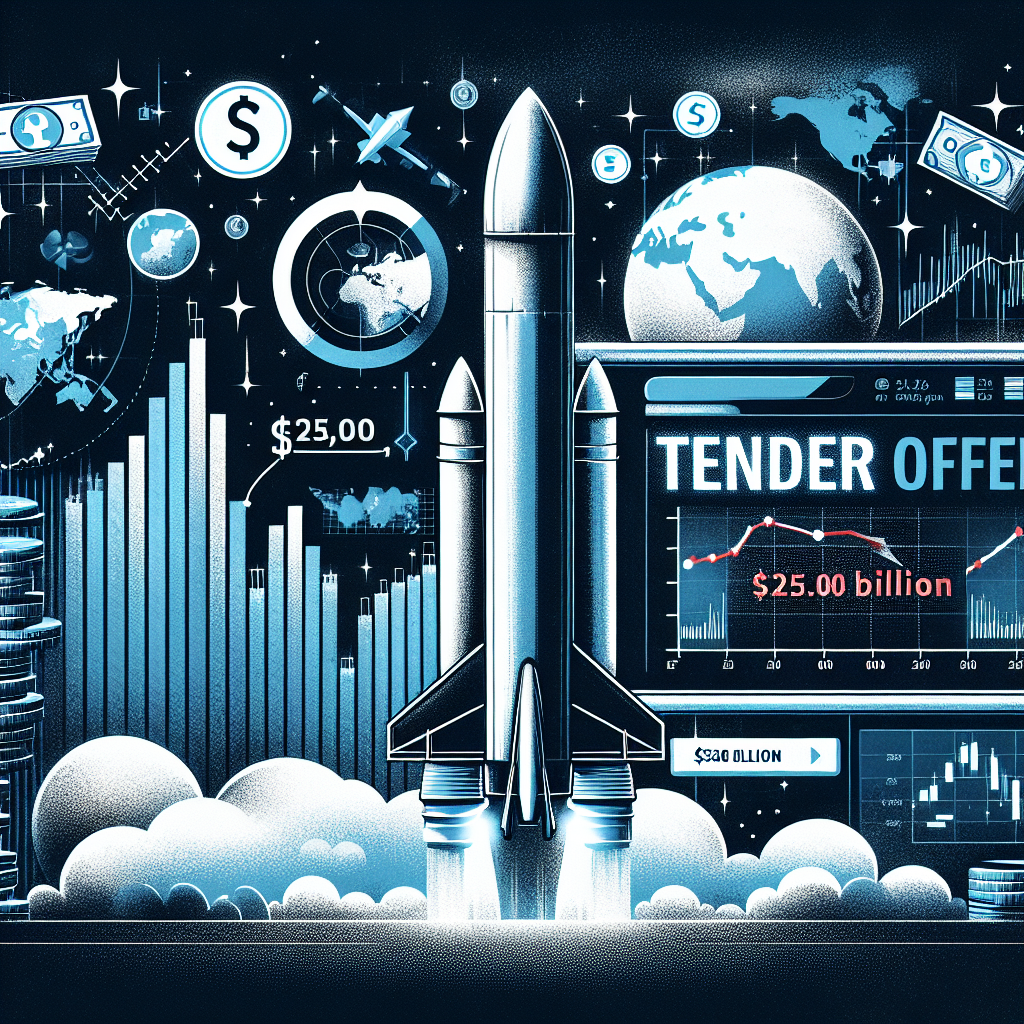“Reaching New Heights: SpaceX’s $250 Billion Valuation Soars with Tender Offer Plans”
Introduction
SpaceX, the pioneering aerospace manufacturer and space transportation company founded by Elon Musk, is reportedly planning a tender offer that could significantly impact its financial landscape. According to recent reports, the company is valued at an impressive $250 billion, underscoring its dominant position in the space industry. This valuation reflects SpaceX’s continued success in launching and developing cutting-edge space technologies, including its ambitious Starship program and the expansive Starlink satellite internet constellation. The tender offer is expected to provide liquidity to existing shareholders while attracting new investors eager to participate in SpaceX’s groundbreaking ventures. As the company continues to push the boundaries of space exploration and commercial spaceflight, this financial maneuver could further solidify its role as a leader in the rapidly evolving space sector.
SpaceX’s Strategic Move: Understanding the Tender Offer
SpaceX, the pioneering aerospace manufacturer and space transportation company founded by Elon Musk, is reportedly planning a tender offer that could significantly impact its valuation. According to recent reports, this strategic move is set to value the company at an impressive $250 billion. As SpaceX continues to push the boundaries of space exploration and commercial space travel, understanding the implications of this tender offer is crucial for stakeholders and industry observers alike.
A tender offer, in essence, is a bid to purchase some or all of shareholders’ shares in a corporation. Typically, this is done at a premium to the current market price, providing an incentive for shareholders to sell their holdings. For SpaceX, a private company, the tender offer represents an opportunity to manage its equity structure and provide liquidity to its existing shareholders. This move is particularly significant given the company’s ambitious projects and the substantial capital required to fund them.
SpaceX has been at the forefront of revolutionizing space travel, with its ambitious goals of colonizing Mars and making space travel more accessible to the general public. The company’s achievements, such as the successful deployment of the Starlink satellite constellation and the development of the Starship spacecraft, have positioned it as a leader in the aerospace industry. Consequently, the tender offer could be seen as a strategic maneuver to consolidate its financial standing and ensure continued investment in its groundbreaking projects.
Moreover, the valuation of $250 billion underscores the market’s confidence in SpaceX’s potential for future growth. This figure not only reflects the company’s current achievements but also anticipates its future contributions to the space industry. The valuation is a testament to SpaceX’s innovative approach and its ability to capture the imagination of investors and the public alike. It also highlights the increasing importance of private companies in the space sector, traditionally dominated by government agencies.
In addition to providing liquidity, the tender offer may also serve to align the interests of SpaceX’s stakeholders. By offering existing shareholders the opportunity to sell their shares, the company can potentially attract new investors who are aligned with its long-term vision. This could lead to a more cohesive shareholder base, which is essential for a company with such ambitious goals. Furthermore, the tender offer could help SpaceX manage its capital structure more effectively, ensuring that it has the necessary resources to continue its pioneering work.
As SpaceX moves forward with this tender offer, it is essential to consider the broader implications for the aerospace industry. The company’s success has already spurred increased interest and investment in space exploration, and its continued growth could further accelerate this trend. By setting a high valuation benchmark, SpaceX may encourage other private companies to pursue similar strategies, potentially leading to a more dynamic and competitive space sector.
In conclusion, SpaceX’s reported tender offer and its valuation of $250 billion represent a significant milestone for the company and the broader aerospace industry. This strategic move not only provides liquidity to existing shareholders but also positions SpaceX for continued growth and innovation. As the company continues to push the boundaries of what is possible in space exploration, its actions will undoubtedly have far-reaching implications for the future of the industry.
Valuation Insights: How SpaceX Reached $250 Billion
SpaceX, the pioneering aerospace manufacturer and space transportation company founded by Elon Musk, has reportedly reached a staggering valuation of $250 billion. This remarkable milestone underscores the company’s rapid ascent in the aerospace industry and highlights its pivotal role in shaping the future of space exploration and satellite technology. The valuation, which has been reported in conjunction with plans for a tender offer, reflects the growing confidence in SpaceX’s ambitious projects and its ability to deliver on its promises.
To understand how SpaceX achieved this impressive valuation, it is essential to consider the company’s strategic initiatives and technological advancements. One of the key factors contributing to SpaceX’s success is its innovative approach to rocket design and reusability. The development of the Falcon 9 rocket, which is capable of landing and being reused multiple times, has significantly reduced the cost of launching payloads into space. This breakthrough has not only made space more accessible but has also positioned SpaceX as a leader in the commercial spaceflight sector.
Moreover, SpaceX’s ambitious Starship program, which aims to enable human colonization of Mars, has captured the imagination of investors and the public alike. The Starship, designed to be a fully reusable spacecraft, represents a significant leap forward in space travel technology. Its potential to revolutionize interplanetary travel and establish a human presence on other celestial bodies has been a major driver of SpaceX’s valuation. The successful test flights and ongoing development of the Starship have further solidified investor confidence in the company’s long-term vision.
In addition to its groundbreaking work in rocketry, SpaceX has made significant strides in satellite technology through its Starlink project. Starlink aims to provide global high-speed internet coverage by deploying a constellation of thousands of small satellites in low Earth orbit. This initiative has the potential to transform internet accessibility worldwide, particularly in remote and underserved regions. The commercial success of Starlink, which has already begun offering services in several countries, has been a crucial factor in boosting SpaceX’s valuation.
Furthermore, SpaceX’s strategic partnerships and contracts with government agencies, such as NASA, have played a vital role in its financial growth. The company’s collaboration with NASA on the Commercial Crew Program, which involves transporting astronauts to and from the International Space Station, has not only generated significant revenue but has also demonstrated SpaceX’s reliability and capability in human spaceflight. These partnerships have reinforced the company’s reputation as a trusted partner in the aerospace industry.
As SpaceX continues to push the boundaries of space exploration and technology, its valuation reflects the market’s optimism about its future prospects. The planned tender offer, which allows existing shareholders to sell their shares at the current valuation, indicates a strong demand for SpaceX’s stock and a belief in its continued growth trajectory. This move also provides liquidity to early investors and employees, further aligning their interests with the company’s long-term success.
In conclusion, SpaceX’s valuation of $250 billion is a testament to its innovative spirit, strategic vision, and technological prowess. By revolutionizing rocket reusability, advancing satellite technology, and forging strategic partnerships, SpaceX has positioned itself as a leader in the aerospace industry. As the company continues to pursue its ambitious goals, it remains at the forefront of shaping the future of space exploration and connectivity, capturing the imagination of investors and the public alike.
The Impact of SpaceX’s Valuation on the Aerospace Industry
SpaceX, the pioneering aerospace manufacturer and space transportation company founded by Elon Musk, has recently been valued at an astounding $250 billion, according to a report. This valuation, which positions SpaceX as one of the most valuable private companies globally, is set to have significant implications for the aerospace industry. As SpaceX plans a tender offer, the ripple effects of this valuation are likely to be felt across various facets of the sector, influencing investment trends, competitive dynamics, and technological advancements.
To begin with, SpaceX’s valuation underscores the growing investor confidence in the commercial space sector. The company’s success in reducing the cost of space travel through innovations such as the reusable Falcon 9 rocket has not only captured the imagination of the public but also attracted substantial investment. This influx of capital is indicative of a broader trend where private investment in space technology is becoming increasingly mainstream. Consequently, other aerospace companies, both established players and startups, may find themselves under pressure to innovate and demonstrate similar potential for growth to attract investment.
Moreover, SpaceX’s valuation highlights the shifting competitive landscape within the aerospace industry. Traditionally dominated by government agencies and a few large defense contractors, the industry is now witnessing a paradigm shift. SpaceX’s achievements, including its role in NASA’s Commercial Crew Program and its ambitious Starlink satellite internet project, have set new benchmarks for what private companies can accomplish. This has prompted other companies to reevaluate their strategies, leading to increased competition and collaboration in areas such as satellite deployment, space tourism, and deep-space exploration.
In addition to influencing investment and competition, SpaceX’s valuation is likely to accelerate technological advancements within the industry. The company’s focus on innovation has already led to significant breakthroughs, such as the development of the Starship spacecraft, which aims to enable human colonization of Mars. As SpaceX continues to push the boundaries of what is possible, other companies may be inspired or compelled to pursue their own ambitious projects. This could result in a rapid pace of technological development, with new materials, propulsion systems, and space habitats emerging as companies strive to keep up with SpaceX’s momentum.
Furthermore, the valuation of SpaceX may have implications for regulatory frameworks governing the aerospace industry. As private companies play an increasingly prominent role in space exploration and commercialization, there may be a need for updated regulations to address issues such as space traffic management, environmental impact, and international cooperation. Policymakers will need to balance the encouragement of innovation with the protection of public interests, ensuring that the benefits of space exploration are shared widely and sustainably.
In conclusion, SpaceX’s recent valuation of $250 billion is a testament to the company’s remarkable achievements and its potential to shape the future of the aerospace industry. As SpaceX plans a tender offer, the impact of this valuation will likely be felt across investment trends, competitive dynamics, technological advancements, and regulatory frameworks. The aerospace industry stands on the cusp of a new era, driven by the vision and accomplishments of companies like SpaceX. As this transformation unfolds, stakeholders across the sector will need to adapt and innovate to harness the opportunities and address the challenges that lie ahead.
Investor Reactions to SpaceX’s Tender Offer Announcement

SpaceX, the pioneering aerospace manufacturer and space transportation company founded by Elon Musk, has recently announced plans for a tender offer that has captured the attention of investors worldwide. This move, which values the company at an impressive $250 billion, marks a significant milestone in SpaceX’s journey and has prompted a variety of reactions from the investment community. As the company continues to push the boundaries of space exploration and satellite technology, the tender offer represents both an opportunity and a challenge for investors seeking to align themselves with SpaceX’s ambitious vision.
The announcement of the tender offer comes at a time when SpaceX is riding high on a series of successful missions and technological advancements. The company’s achievements, such as the development of the reusable Falcon 9 rocket and the ongoing deployment of the Starlink satellite constellation, have solidified its reputation as a leader in the aerospace industry. Consequently, the valuation of $250 billion reflects not only SpaceX’s current accomplishments but also its potential for future growth and innovation. For investors, this valuation serves as a testament to the company’s robust business model and its ability to generate substantial returns.
In light of the tender offer, investors are carefully considering the implications of participating in this financial maneuver. On one hand, the offer provides an opportunity for existing shareholders to realize gains on their investments, given the substantial increase in SpaceX’s valuation over recent years. This prospect is particularly appealing to early investors who have witnessed the company’s evolution from a fledgling startup to a dominant force in the space industry. On the other hand, some investors may be hesitant to sell their shares, anticipating further appreciation in value as SpaceX continues to expand its operations and explore new frontiers.
Moreover, the tender offer has sparked discussions about the broader impact of SpaceX’s valuation on the aerospace sector. As one of the most valuable private companies globally, SpaceX’s financial standing sets a benchmark for other companies in the industry. This development may influence investment strategies and valuations of other aerospace firms, as investors reassess their portfolios in light of SpaceX’s success. Additionally, the tender offer underscores the growing interest in space-related ventures, highlighting the sector’s potential to attract significant capital and drive technological advancements.
While the tender offer is a focal point for investors, it also raises questions about SpaceX’s long-term strategic goals. The company has consistently demonstrated its commitment to reducing the cost of space travel and making it more accessible. As SpaceX continues to pursue its mission of enabling human life on Mars, the tender offer could provide the necessary capital to fund ambitious projects and accelerate the timeline for achieving these objectives. Consequently, investors are keenly observing how the proceeds from the tender offer will be utilized to further SpaceX’s mission and enhance its competitive edge.
In conclusion, SpaceX’s announcement of a tender offer, valuing the company at $250 billion, has elicited a range of reactions from investors. While some view it as an opportunity to capitalize on their investments, others see it as a chance to support SpaceX’s long-term vision. As the company continues to innovate and lead the aerospace industry, the tender offer serves as a pivotal moment that could shape the future of space exploration and investment in the sector. Investors will undoubtedly be watching closely as SpaceX navigates this new phase in its remarkable journey.
Comparing SpaceX’s Valuation with Other Tech Giants
SpaceX, the pioneering aerospace manufacturer and space transportation company founded by Elon Musk, has recently been valued at an impressive $250 billion, according to a report. This valuation comes as the company plans a tender offer, a move that has captured the attention of investors and industry analysts alike. As SpaceX continues to push the boundaries of space exploration and satellite technology, its valuation places it in a unique position among the world’s leading tech giants. To better understand the significance of this valuation, it is essential to compare SpaceX’s standing with other major players in the technology sector.
In recent years, SpaceX has emerged as a formidable force in the aerospace industry, driven by its ambitious projects such as the Starship spacecraft and the Starlink satellite internet constellation. These initiatives have not only demonstrated SpaceX’s technological prowess but have also opened up new revenue streams, contributing to its soaring valuation. When juxtaposed with other tech giants, SpaceX’s $250 billion valuation is particularly noteworthy. For instance, companies like Apple, Microsoft, and Amazon have long been valued in the trillions, yet SpaceX’s rapid ascent in valuation is remarkable given its relatively niche focus on space technology.
Moreover, SpaceX’s valuation surpasses that of many established tech companies that have been in operation for decades. For example, Intel, a stalwart in the semiconductor industry, and IBM, a pioneer in computing, have market capitalizations that hover around the same range as SpaceX’s current valuation. This comparison highlights the growing investor confidence in the potential of space technology and the future revenue streams it promises. Furthermore, it underscores the shifting landscape of the tech industry, where traditional sectors are being challenged by innovative companies with futuristic visions.
In addition to its technological achievements, SpaceX’s valuation is also a testament to its successful business model. The company has secured lucrative contracts with NASA and other international space agencies, providing a steady stream of income that bolsters its financial standing. Additionally, the commercial launch market, where SpaceX has established itself as a leader, offers significant growth opportunities. This diversification of revenue sources not only enhances SpaceX’s financial stability but also positions it favorably against other tech giants that may rely heavily on a single product or service line.
Transitioning to the broader implications of SpaceX’s valuation, it is evident that the company’s success is indicative of a larger trend within the tech industry. As technological advancements continue to accelerate, companies that are able to innovate and adapt are increasingly being rewarded with higher valuations. This trend is not limited to the aerospace sector; it is also observable in areas such as artificial intelligence, renewable energy, and biotechnology. Consequently, SpaceX’s valuation serves as a bellwether for the future of technology, where the convergence of different fields is likely to drive unprecedented growth and transformation.
In conclusion, SpaceX’s $250 billion valuation is a significant milestone that reflects both its achievements and the broader shifts occurring within the tech industry. By comparing SpaceX with other tech giants, it becomes clear that the company’s focus on innovation and diversification has positioned it as a leader in the rapidly evolving landscape of technology. As SpaceX continues to pursue its ambitious goals, its valuation not only underscores its current success but also hints at the vast potential that lies ahead in the realm of space exploration and beyond.
Future Prospects: What SpaceX’s Valuation Means for Space Exploration
SpaceX, the private aerospace manufacturer and space transportation company founded by Elon Musk, has recently been valued at an impressive $250 billion, according to a report. This valuation comes as the company plans a tender offer, a move that has captured the attention of investors and space enthusiasts alike. The substantial valuation not only underscores SpaceX’s significant achievements in the aerospace sector but also highlights its potential to shape the future of space exploration. As we delve into the implications of this valuation, it is essential to consider how SpaceX’s financial standing could influence the broader landscape of space exploration.
To begin with, SpaceX’s valuation reflects its pivotal role in revolutionizing space travel. The company has consistently pushed the boundaries of what is possible, from launching the first privately-funded spacecraft to reach orbit to developing the Falcon Heavy, the most powerful operational rocket in the world. These accomplishments have not only demonstrated SpaceX’s technical prowess but have also paved the way for more ambitious projects, such as the Starship program, which aims to enable human colonization of Mars. Consequently, the $250 billion valuation is a testament to the company’s innovative spirit and its potential to drive humanity’s next steps into the cosmos.
Moreover, the tender offer indicates SpaceX’s strategic approach to securing additional capital, which could be instrumental in funding its future endeavors. By offering existing shareholders the opportunity to sell their shares, SpaceX can attract new investors who are eager to support its ambitious projects. This influx of capital could accelerate the development of key initiatives, such as the Starlink satellite internet constellation, which aims to provide global internet coverage, and the Starship program, which is crucial for deep space exploration. As a result, SpaceX’s financial strategy could significantly impact the pace and scope of its contributions to space exploration.
In addition to its technical achievements and financial strategies, SpaceX’s valuation also highlights the growing interest in the commercial space sector. As private companies like SpaceX continue to demonstrate their capabilities, they are increasingly seen as viable partners for government space agencies. This collaboration could lead to more efficient and cost-effective space missions, as private companies bring their expertise in innovation and cost management to the table. Furthermore, the success of SpaceX could inspire other private entities to enter the space industry, fostering a competitive environment that drives further advancements in technology and exploration.
However, it is important to recognize that SpaceX’s valuation also presents challenges. The high expectations associated with such a valuation could put pressure on the company to deliver results quickly, potentially leading to increased scrutiny from investors and the public. Additionally, as SpaceX continues to expand its operations, it must navigate complex regulatory environments and address concerns related to space debris and environmental impact. These challenges underscore the need for SpaceX to balance its ambitious goals with responsible practices that ensure the sustainability of space exploration.
In conclusion, SpaceX’s $250 billion valuation is a significant milestone that reflects its achievements and potential in the aerospace industry. As the company embarks on its next chapter, its financial standing could play a crucial role in shaping the future of space exploration. By leveraging its resources and expertise, SpaceX has the opportunity to drive innovation, foster collaboration, and inspire a new era of exploration that extends beyond our planet. As we look to the future, the implications of SpaceX’s valuation will undoubtedly influence the trajectory of space exploration for years to come.
Analyzing the Financial Health of SpaceX Amidst New Valuation
SpaceX, the pioneering aerospace manufacturer and space transportation company founded by Elon Musk, has recently been thrust into the financial spotlight with reports of a new tender offer that values the company at an astounding $250 billion. This valuation marks a significant milestone in the company’s journey, reflecting its growing influence and success in the space industry. As SpaceX continues to push the boundaries of space exploration and commercial space travel, it is crucial to analyze the financial health of the company amidst this new valuation.
To begin with, SpaceX’s valuation surge can be attributed to its impressive track record of achievements and its strategic positioning in the space sector. The company has successfully launched numerous missions, including the transportation of astronauts to the International Space Station (ISS) and the deployment of its Starlink satellite constellation, which aims to provide global internet coverage. These accomplishments have not only solidified SpaceX’s reputation as a leader in the industry but have also attracted significant investor interest, driving up its valuation.
Moreover, the tender offer, which allows existing shareholders to sell their shares at the new valuation, indicates strong confidence in SpaceX’s future prospects. This move is likely to provide liquidity to early investors and employees, while also potentially attracting new investors eager to be part of SpaceX’s ambitious vision. The tender offer serves as a testament to the company’s robust financial health, as it suggests that SpaceX is in a position to offer attractive returns to its stakeholders.
In addition to its operational successes, SpaceX’s financial health is bolstered by its diverse revenue streams. The company generates income from various sources, including government contracts, commercial satellite launches, and its burgeoning Starlink internet service. This diversification not only mitigates risks associated with reliance on a single revenue stream but also positions SpaceX to capitalize on emerging opportunities in the space economy. As the demand for satellite-based services and space exploration continues to grow, SpaceX is well-positioned to capture a significant share of this expanding market.
Furthermore, SpaceX’s focus on innovation and cost-efficiency has played a pivotal role in its financial success. The company’s development of reusable rocket technology has revolutionized the economics of space travel, significantly reducing launch costs and increasing the frequency of missions. This technological edge not only enhances SpaceX’s competitive advantage but also contributes to its financial sustainability by enabling more cost-effective operations.
However, it is important to consider the challenges that SpaceX may face as it navigates its path forward. The space industry is inherently risky, with technical failures and regulatory hurdles posing potential threats to the company’s operations. Additionally, as SpaceX continues to expand its Starlink service, it must address concerns related to satellite congestion and environmental impact. These challenges, while significant, are not insurmountable, and SpaceX’s track record of overcoming obstacles suggests that it is well-equipped to address them.
In conclusion, SpaceX’s recent valuation of $250 billion, as highlighted by the tender offer, underscores the company’s strong financial health and promising future. With its impressive achievements, diversified revenue streams, and focus on innovation, SpaceX is poised to continue its trajectory of success in the space industry. While challenges remain, the company’s strategic positioning and commitment to pushing the boundaries of space exploration make it a formidable player in the evolving space economy. As SpaceX continues to chart new frontiers, its financial health will undoubtedly play a crucial role in shaping its journey.
Q&A
1. **What is SpaceX planning according to the report?**
SpaceX is planning a tender offer.
2. **What is the reported valuation of SpaceX in this tender offer?**
The company is valued at $250 billion.
3. **What is a tender offer?**
A tender offer is a bid to purchase some or all of shareholders’ shares in a corporation.
4. **Why might SpaceX be conducting a tender offer?**
Companies often conduct tender offers to buy back shares, provide liquidity to shareholders, or raise capital.
5. **How does this valuation compare to previous valuations of SpaceX?**
This valuation represents an increase from previous valuations, indicating growth in the company’s perceived market value.
6. **What factors could contribute to SpaceX’s high valuation?**
Factors may include successful launches, contracts with NASA and other entities, advancements in technology, and future growth prospects.
7. **What impact could this valuation have on SpaceX’s future operations?**
A high valuation could enhance SpaceX’s ability to attract investment, fund new projects, and maintain a competitive edge in the aerospace industry.
Conclusion
SpaceX’s plans for a tender offer, valuing the company at $250 billion, underscore its significant growth and market confidence. This valuation reflects SpaceX’s leadership in the aerospace industry, driven by successful missions, innovative technology, and strategic partnerships. The tender offer could provide liquidity to existing shareholders and attract new investors, further solidifying SpaceX’s financial position and enabling continued investment in ambitious projects like Starship and satellite internet services. Overall, this move highlights SpaceX’s pivotal role in advancing space exploration and commercial spaceflight.





